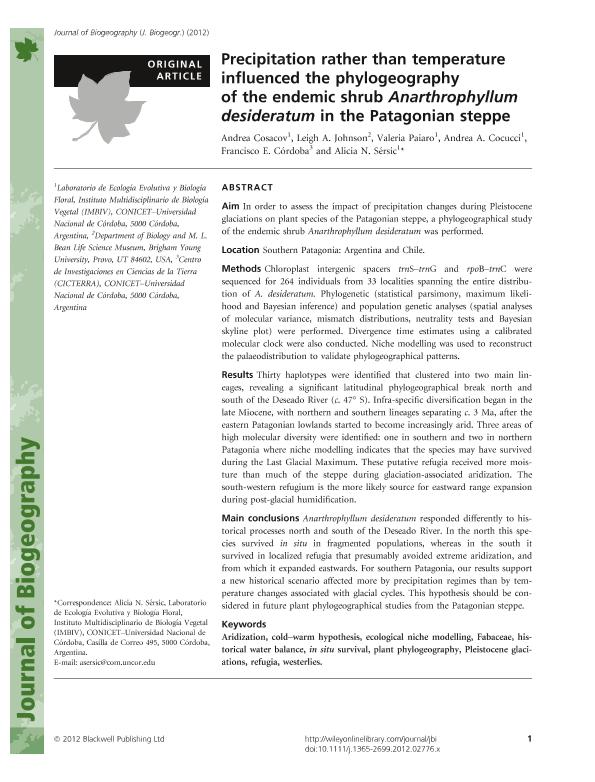Mostrar el registro sencillo del ítem
dc.contributor.author
Cosacov Martinez, Andrea

dc.contributor.author
Johnson, Leigh A.
dc.contributor.author
Paiaro, Valeria

dc.contributor.author
Cocucci, Andrea Aristides

dc.contributor.author
Cordoba, Francisco Elizalde

dc.contributor.author
Sersic, Alicia Noemi

dc.date.available
2017-04-18T18:08:40Z
dc.date.issued
2012-06
dc.identifier.citation
Cosacov Martinez, Andrea; Johnson, Leigh A.; Paiaro, Valeria; Cocucci, Andrea Aristides; Cordoba, Francisco Elizalde; et al.; Precipitation rather than temperature imprinted the phylogeography of the endemic shrub Anarthrophyllum desideratum in the Patagonian steppe; Wiley Blackwell Publishing, Inc; Journal Of Biogeography; 40; 1; 6-2012; 168-182
dc.identifier.issn
0305-0270
dc.identifier.uri
http://hdl.handle.net/11336/15381
dc.description.abstract
Aim In order to assess the impact of precipitation changes during Pleistocene glaciations on plant species of the Patagonian steppe, a phylogeographical study of the endemic shrub Anarthrophyllum desideratum was performed. Location Southern Patagonia: Argentina and Chile. Methods Chloroplast intergenic spacers trnS?trnG and rpoB?trnC were sequenced for 264 individuals from 33 localities spanning the entire distribution of A. desideratum. Phylogenetic (statistical parsimony, maximum likelihood and Bayesian inference) and population genetic analyses (spatial analyses of molecular variance, mismatch distributions, neutrality tests and Bayesian skyline plot) were performed. Divergence time estimates using a calibrated molecular clock were also conducted. Niche modelling was used to reconstruct the palaeodistribution to validate phylogeographical patterns. Results Thirty haplotypes were identified that clustered into two main lineages, revealing a significant latitudinal phylogeographical break north and south of the Deseado River (c.47°S). Infra-specific diversification began in the late Miocene, with northern and southern lineages separating c. 3 Ma, after the eastern Patagonian lowlands started to become increasingly arid. Three areas of high molecular diversity were identified: one in southern and two in northern Patagonia where niche modelling indicates that the species may have survived during the Last Glacial Maximum. These putative refugia received more moisture than much of the steppe during glaciation-associated aridization. The south-western refugium is the more likely source for eastward range expansion during post-glacial humidification. Main conclusions Anarthrophyllum desideratum responded differently to historical processes north and south of the Deseado River. In the north this species survived in situ in fragmented populations, whereas in the south it survived in localized refugia that presumably avoided extreme aridization, and from which it expanded eastwards. For southern Patagonia, our results support a new historical scenario affected more by precipitation regimes than by temperature changes associated with glacial cycles. This hypothesis should be considered in future plant phylogeographical studies from the Patagonian steppe. Keywords Aridization, cold?warm hypothesis, ecological niche modelling, Fabaceae, historical water balance, in situ survival, plant phylogeography, Pleistocene glaciations, refugia, westerlies.
dc.format
application/pdf
dc.language.iso
eng
dc.publisher
Wiley Blackwell Publishing, Inc

dc.rights
info:eu-repo/semantics/openAccess
dc.rights.uri
https://creativecommons.org/licenses/by-nc-sa/2.5/ar/
dc.subject
Patagonia
dc.subject
Legume
dc.subject
Evolution
dc.subject
Climate
dc.subject.classification
Ciencias de las Plantas, Botánica

dc.subject.classification
Ciencias Biológicas

dc.subject.classification
CIENCIAS NATURALES Y EXACTAS

dc.title
Precipitation rather than temperature imprinted the phylogeography of the endemic shrub Anarthrophyllum desideratum in the Patagonian steppe
dc.type
info:eu-repo/semantics/article
dc.type
info:ar-repo/semantics/artículo
dc.type
info:eu-repo/semantics/publishedVersion
dc.date.updated
2017-04-12T17:58:48Z
dc.journal.volume
40
dc.journal.number
1
dc.journal.pagination
168-182
dc.journal.pais
Reino Unido

dc.journal.ciudad
Londres
dc.description.fil
Fil: Cosacov Martinez, Andrea. Consejo Nacional de Investigaciones Científicas y Técnicas. Centro Científico Tecnológico Córdoba. Instituto Multidisciplinario de Biología Vegetal (p); Argentina. Universidad Nacional de Córdoba; Argentina
dc.description.fil
Fil: Johnson, Leigh A.. Brigham Young
University. Department of Biology and M. L.
Bean Life Science Museum; Estados Unidos
dc.description.fil
Fil: Paiaro, Valeria. Consejo Nacional de Investigaciones Científicas y Técnicas. Centro Científico Tecnológico Córdoba. Instituto Multidisciplinario de Biología Vegetal (p); Argentina. Universidad Nacional de Córdoba; Argentina
dc.description.fil
Fil: Cocucci, Andrea Aristides. Consejo Nacional de Investigaciones Científicas y Técnicas. Centro Científico Tecnológico Córdoba. Instituto Multidisciplinario de Biología Vegetal (p); Argentina. Universidad Nacional de Córdoba; Argentina
dc.description.fil
Fil: Cordoba, Francisco Elizalde. Consejo Nacional de Investigaciones Científicas y Técnicas. Centro Científico Tecnológico Córdoba. Centro de Investigaciones En Ciencias de la Tierra; Argentina. Universidad Nacional de Córdoba; Argentina
dc.description.fil
Fil: Sersic, Alicia Noemi. Consejo Nacional de Investigaciones Científicas y Técnicas. Centro Científico Tecnológico Córdoba. Instituto Multidisciplinario de Biología Vegetal (p); Argentina. Universidad Nacional de Córdoba; Argentina
dc.journal.title
Journal Of Biogeography

dc.relation.alternativeid
info:eu-repo/semantics/altIdentifier/url/http://onlinelibrary.wiley.com/doi/10.1111/j.1365-2699.2012.02776.x/abstract
dc.relation.alternativeid
info:eu-repo/semantics/altIdentifier/doi/http://dx.doi.org/10.1111/j.1365-2699.2012.02776.x
Archivos asociados
